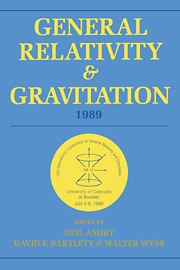 General Relativity and Gravitation, 1989
General Relativity and Gravitation, 1989 Book contents
- Frontmatter
- Contents
- Preface
- Conference committees
- Part A Classical relativity and gravitation theory
- WORKSHOPS
- Part B Relativistic astrophysics, early universe, and classical cosmology
- WORKSHOPS
- B1 Mathematical cosmology
- B2 The early universe
- B3 Relativistic astrophysics
- B4 Astrophysical and observational cosmology
- Part C Experimental gravitation and gravitational wave detection
- WORKSHOPS
- Part D Quantum gravity, superstrings, quantum cosmology
- WORKSHOPS
- Part E Overviews-past, present, and future
B4 - Astrophysical and observational cosmology
Published online by Cambridge University Press: 05 March 2012
- Frontmatter
- Contents
- Preface
- Conference committees
- Part A Classical relativity and gravitation theory
- WORKSHOPS
- Part B Relativistic astrophysics, early universe, and classical cosmology
- WORKSHOPS
- B1 Mathematical cosmology
- B2 The early universe
- B3 Relativistic astrophysics
- B4 Astrophysical and observational cosmology
- Part C Experimental gravitation and gravitational wave detection
- WORKSHOPS
- Part D Quantum gravity, superstrings, quantum cosmology
- WORKSHOPS
- Part E Overviews-past, present, and future
Summary
Twenty six abstracts were submitted for this workshop, seven of which were selected for oral presentation. The main topics covered were gravitational lensing (9 abstracts), large-scale structure (6 abstracts) and cosmic strings (4 abstracts), all of these topics being represented in the talks. These are not the only areas which have seen important advances recently but they are perhaps the most interesting ones from the perspective of a relativist. In this report I will summarize the contents of the talks, referring to some of the posters where appropriate. Whenever distance scales arise, the Hubble parameter is assumed to be 50 km/s/Mpc.
Gravitational lensing
Blandford's plenary contribution (Chapter 5, this volume) illustrates the increasing usefulness of gravitational lensing as a cosmological tool in recent years and this is reflected in the large number of abstracts on the topic. Besides confirming light-bending itself, gravitational lensing can provide evidence of the existence and distribution of dark matter in galaxies, identify the presence of objects on scales from jupiters to supermassive black holes, probe features of large-scale structure, and perhaps even measure the Hubble constant. The posters of Ho Tenlin and Yakimov illustrated how particular instances of gravitational lensing can provide cosmological information. The talks focussed on more general mathematical issues.
The interpretation of observations of distant objects is complicated by the fact that a beam of light may suffer many weak gravitational encounters rather than a single strong one as it propagates through an inhomogeneous background.
- Type
- Chapter
- Information
- General Relativity and Gravitation, 1989Proceedings of the 12th International Conference on General Relativity and Gravitation, pp. 263 - 270Publisher: Cambridge University PressPrint publication year: 1990


